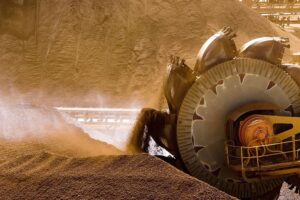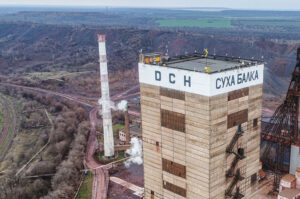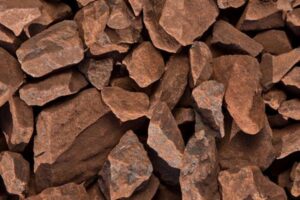
In January-June of this year, Ukrainian mining companies increased exports of iron ore in physical terms by 2.2 times compared to the same period last year, to 18 million 315.164 thousand tons.
According to the statistics released by the State Customs Service on Tuesday, foreign exchange earnings from iron ore exports increased by 78.8% to $1 billion 602.255 million over the period.
Iron ore was exported mainly to China (38.66% of supplies in monetary terms), Slovakia (16.46%) and Poland (15.83%).
In January-June 2024, Ukraine imported iron ore worth $151 thousand in the total amount of 330 tons, while in January-June 2023 it imported iron ore worth $42 thousand in the total amount of 68 tons. Imports this year were carried out from the Netherlands (47.02%), Italy (19.87%) and Norway (18.54%).
As reported, in 2023, Ukraine decreased exports of iron ore in physical terms by 26% compared to 2022 – to 17 million 753.165 thousand tons, foreign exchange earnings from iron ore exports amounted to $1 billion 766.906 million (down 39.3%). Iron ore was exported mainly to Slovakia (28.39% of supplies in monetary terms), the Czech Republic (19.74%) and Poland (19.56%).
Last year, Ukraine imported iron ore worth $135 thousand in the total amount of 250 tons. During this period, imports were made from Norway (34.81%), Italy (28.89%) and the Netherlands (28.89%). While in 2022, iron ore was imported for $65 thousand in a total volume of 101 tons.

In January-May this year, Ukrainian mining companies increased exports of iron ore in physical terms by 2.27 times compared to the same period last year, to 15 million 542.428 thousand tons.
According to the statistics released by the State Customs Service on Thursday, foreign exchange earnings from iron ore exports increased by 81.7% to $1 billion 367.161 million during the period under review.
Exports of iron ore were carried out mainly to China (40.53% of supplies in monetary terms), Slovakia (15.65%) and Poland (14.91%).
In January-May 2024, Ukraine imported iron ore worth $121 thousand in the total volume of 303 tons, while in January-May 2023 it imported iron ore worth $42 thousand in the total volume of 68 tons. This year’s imports were carried out from the Netherlands (39.67%), Norway (23.14%) and Italy (20.66%).
As reported, in 2023, Ukraine decreased exports of iron ore in physical terms by 26% compared to 2022 – to 17 million 753.165 thousand tons, foreign exchange earnings from iron ore exports amounted to $1 billion 766.906 million (down 39.3%). Iron ore was exported mainly to Slovakia (28.39% of supplies in monetary terms), the Czech Republic (19.74%) and Poland (19.56%).
Last year, Ukraine imported iron ore worth $135 thousand in the total amount of 250 tons. During this period, imports were made from Norway (34.81%), Italy (28.89%) and the Netherlands (28.89%). While in 2022, iron ore was imported for $65 thousand in a total volume of 101 tons.
In 2022, Ukraine decreased exports of iron ore in physical terms by 45.9% compared to 2021 – to 23 million 984.623 thousand tons, while foreign exchange earnings decreased by 57.8% to $2 billion 912.974 million. Iron ore was exported mainly to Slovakia (19.23% of supplies in monetary terms), the Czech Republic (17.32%) and Poland (16.49%).
In 2022, Ukraine imported iron ore worth $65 thousand in a total volume of 101 tons, while in 2021 – $184 thousand in a volume of 1,202 thousand tons. Imports were carried out from Norway (36.92%), the Netherlands (27.69%) and the UK (16.92%).

Sukha Balka mine (Kryvyi Rih, Dnipropetrovs’k region), part of Aleksandr Yaroslavsky’s DCH Group, commissioned a new longwall at Yubileynaya mine in early May.
According to the DCH Steel corporate newspaper, on Thursday, May 8, miners of the 17th section carried out the first explosion in block 34-36, located on the 1st floor of the Gnezdo 1-2 deposit at a horizon of -1420 m. Ore reserves in the block amount to 244 thousand tons.
“Thanks to the high quality of ore, the mine operated steadily in May and ensured stable operations in June,” the company said in a statement.
It also specifies that self-propelled equipment, namely a DERUI loading and delivery machine, was used to perform the cutting operations.
“The mine employees made every effort to deliver the block on time and with a good grade. Thanks to this, Yubileynaya Mine can confidently work on ore production in the near future,” said Vladimir Moiseichenko, head of the mine’s production department.
It is also reported that in the first quarter of 2024, the mine increased the payment of taxes and fees to the budgets of all levels by 45% to UAH 81 million compared to the same period last year. At the same time, the rent for the use of subsoil for mining increased significantly, by almost 2.5 times to UAH 42.5 million. The amount of the unified social tax remained at the level of the first quarter of 2023 and amounted to UAH 16.4 million.
Sukha Balka mine is one of the leading mining companies in Ukraine. It produces iron ore by underground mining. It includes Yubileynaya and Frunze mines.
DCH Group acquired the mine from Evraz Group in May 2017.
According to the third quarter of 2023, Yaroslavsky, who is designated as a non-resident of Ukraine (British citizen – IF-U), directly owns 77.4193% of the mine’s shares, while resident individual Artem Aleksandrov owns 20%.
The authorized capital of Sukha Balka PrJSC is UAH 41.869 million, with a share par value of UAH 0.05.

In January-April this year, Ukrainian mining companies increased exports of iron ore in physical terms by 2.1 times compared to the same period last year, to 11 million 28,545 thousand tons.
According to statistics released by the State Customs Service (SCS) on Friday, foreign exchange earnings from iron ore exports increased 4.1 times to $2 billion 409.852 million over the period under review.
At the same time, 9 million 4.370 thousand tons of iron ore worth $863.315 million were exported in 3 months of 2014.
Iron ore was exported mainly to China (43.03% of supplies in monetary terms), Slovakia (16.29%) and Poland (13.67%).
In January-April 2024, Ukraine imported iron ore worth $72 thousand in a total volume of 252 tons, while in January-April 2023, it imported $41 thousand in a total volume of 67 tons. Imports were carried out from the Netherlands (29.17%), Italy (25%) and Norway (18.06%).
As reported, in 2023, Ukraine decreased the export of iron ore in physical terms by 26% compared to 2022 – to 17 million 753.165 thousand tons, foreign exchange earnings from iron ore exports amounted to $1 billion 766.906 million (down 39.3%). Iron ore was exported mainly to Slovakia (28.39% of supplies in monetary terms), the Czech Republic (19.74%) and Poland (19.56%).
Last year, Ukraine imported iron ore worth $135 thousand in the total amount of 250 tons. During this period, imports were made from Norway (34.81%), Italy (28.89%) and the Netherlands (28.89%). While in 2022, iron ore was imported for $65 thousand in a total volume of 101 tons.
In 2022, Ukraine decreased exports of iron ore in physical terms by 45.9% compared to 2021 – to 23 million 984.623 thousand tons, while foreign exchange earnings decreased by 57.8% to $2 billion 912.974 million. Iron ore was exported mainly to Slovakia (19.23% of supplies in monetary terms), the Czech Republic (17.32%) and Poland (16.49%).
In 2022, Ukraine imported iron ore worth $65 thousand in a total volume of 101 tons, while in 2021 – $184 thousand in a volume of 1,202 thousand tons. Imports were carried out from Norway (36.92%), the Netherlands (27.69%) and the UK (16.92%).

Mining enterprises of Ukraine in January-March this year increased exports of iron ore raw materials (iron ore) in physical terms by 2.5 times compared to the same period last year – up to 9 million 4,370 thousand tons.
According to statistics released by the State Customs Service (SCS), foreign currency earnings from iron ore exports increased by 2.1 times to $863.315 million for the period.
Exports of iron ore were mainly to China (43.02% of shipments in monetary terms), Slovakia (17.02%) and Poland (12.41%).
In the first three months of 2024 Ukraine imported $67 thousand worth of iron ore in the total volume of 245 tons, while in January-March 2023 it imported $22 thousand worth of iron ore in the total volume of 36 tons. Imports were made from the Netherlands (31.82%), Norway (19.70%) and Italy (18.18%).
As reported, Ukraine in 2023 reduced exports of iron ore in physical terms by 26% compared to 2022 – to 17 million 753.165 thousand tons, foreign currency earnings from iron ore exports amounted to $1 billion 766.906 million (down 39.3%). Exports of iron ore were mainly exported to Slovakia (28.39% of shipments in monetary terms), the Czech Republic (19.74%) and Poland (19.56%).
Last year Ukraine imported iron ore products worth $135 thousand in the total volume of 250 tons. Imports for this period were made from Norway (34.81%), Italy (28.89%) and the Netherlands (28.89%). Whereas in 2022, $65 thousand worth of iron ore was imported in a total volume of 101 tons.
Ukraine in 2022 decreased its iron ore exports in physical terms by 45.9% compared to 2021 – to 23 million 984.623 thousand tons, while foreign currency earnings decreased by 57.8% – to $2 billion 912.974 million. The iron ore exports were mainly to Slovakia (19.23% of shipments in monetary terms), Czech Republic (17.32%) and Poland (16.49%).
In 2022, Ukraine imported iron ore products worth $65 thousand in the total volume of 101 tons, while in 2021 – $184 thousand in the volume of 1,202 tons. Imports were made from Norway (36.92%), the Netherlands (27.69%) and the UK (16.92%).

In January-February of this year, Ukrainian mining companies increased exports of iron ore in physical terms by 2.64 times compared to the same period last year, to 5 million 664.230 thousand tons.
According to the statistics released by the State Customs Service on Wednesday, foreign exchange earnings from iron ore exports increased 2.34 times to $552.818 million over the period under review.
Iron ore was exported mainly to China (40.32% of supplies in monetary terms), Slovakia (17.22%) and Poland (11.50%).
In the first two months of 2024, Ukraine imported iron ore worth $29 thousand in a total volume of 102 tons, while in January-February 2023, it imported iron ore worth $17 thousand in a volume of 28 thousand tons. Imports in January-February 2024 were carried out from Norway (44.83%), Slovakia (27.59%) and Italy (27.59%).
As reported, in 2023, Ukraine decreased exports of iron ore in physical terms by 26% compared to 2022 – to 17 million 753.165 thousand tons, foreign exchange earnings from iron ore exports amounted to $1 billion 766.906 million (down 39.3%). Iron ore was exported mainly to Slovakia (28.39% of supplies in monetary terms), the Czech Republic (19.74%) and Poland (19.56%).
Last year, Ukraine imported iron ore worth $135 thousand in the total amount of 250 tons. During this period, imports were made from Norway (34.81%), Italy (28.89%) and the Netherlands (28.89%). While in 2022, iron ore was imported for $65 thousand in a total volume of 101 tons.
In 2022, Ukraine decreased exports of iron ore in physical terms by 45.9% compared to 2021 – to 23 million 984.623 thousand tons, while foreign exchange earnings decreased by 57.8% to $2 billion 912.974 million. Iron ore was exported mainly to Slovakia (19.23% of supplies in monetary terms), the Czech Republic (17.32%) and Poland (16.49%).
In 2022, Ukraine imported iron ore worth $65 thousand in a total volume of 101 tons, while in 2021 – $184 thousand in a volume of 1,202 thousand tons. Imports were carried out from Norway (36.92%), the Netherlands (27.69%) and the UK (16.92%).